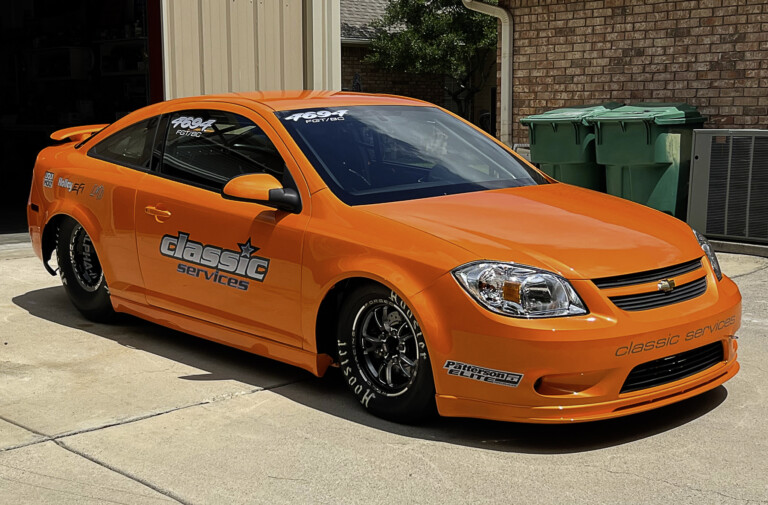Steven Kronemberger is a man with exacting standards. Not only does this mean that his cars are exceptionally well built, but it means he’s able to exploit just about all of the performance they can offer on any given day, regardless of the conditions. That said, the violent power delivery of the his Honda Civic Type R K20C1 engine requires Kronemberger to proceed with caution if he wants to avoid much wheelspin—not something easily done in a front-wheel drive car with 360 lb-ft of torque!
As we discussed with Honda Research Team West’s Tom O’Gorman, a special throttle technique is needed to put the latest Civic Type R power to the pavement with a minimum of wheelspin. “I try to preload the differential with about 20% throttle on entry. This facilitates rotation into the apex, and I only get to full throttle when the car is about straight,” he described. Of course, later apexes and more trail braking were needed too. Kronemberger was familiar with all those techniques, but his modified engine’s output required a little extra to turn its power into propulsion.

The Type R platform is kept flat with top-dollar JRZ coilovers. Photo credit: CaliPhotography
The Pirelli DH tires struggled to put the 360 horsepower and 360 lb-ft of torque to the ground, so Kronemberger went a step further and opted for a Hondata traction control system. This is precisely what’s needed to get the most ponies to the pavement in any circumstance with such a layout. Often dirty, off-camber, and tightening in spots, Buttonwillow is one of the best places to test this technology.
This clever system does help Kronemberger take slightly shallower lines, since he no longer needs to square off the corner to the extent he once did. An unintrusive reduction in power, but no drastic cut, allows him to keep his mid-corner speeds up and get to full throttle sooner than before. He’s able to use more of the power more of the time—simply by calibrating the Hondata system to work with the different upgrades.

Seeing a half-million dollar race car in your mirrors is a great antidepressant. Photo credit: CaliPhotography
This Civic, while still street legal, boasts a bevy of modifications that help it straddle the fence between roaddom and racedom. For improved handling, the Civic sports JRZ RS Pro coilovers, an ASR rear swaybar, and Titan 7 wheels housing Winmax brake pads and Girodisc rotors. A bump in power comes courtesy of a Remark exhaust, a PRL downpipe and intercooler, and a tune from Hondata. The motor is kept cool Greddy oil cooler and a beefy Koyo radiator, and Kronemberger is kept safe and secure with a Recaro Pole Position seat and a Evasive cage. This list of modifications give the CTR the ability to outrun a Corvette Zo6—so how does it fare against an Audi R8 GT3?
Quite well. Granted, the man behind the wheel of the Audi R8 isn’t Alain Prost, but even a capable driver should have no difficulty rocketing away from a modified Civic. Perhaps that would’ve been the case in a stock vs. stock scenario, but the systems in the Civic help level the playing field. Listen carefully to how Kronemberger’s wheels start to spin over Turn 2’s crest (0:45). The wheelspin is minimized thanks to the Hondata system, which allows him to roll over the top of the hill without laying long black stripes. That traction, when combined with Kronemberger’s tidy lines and confidence in the front axle, closes the gap stretched on every straight by the V10-powered Audi. You can imagine how proud Kronemberger must’ve felt once given the point-by.
Free from pesky half-million dollar race cars, Kronemberger managed one of the fastest CTR laps at Buttonwillow yet.
Later that day, he put together an exceptionally tidy, traffic-free lap free of 1:52.7—nearly ten seconds faster than the stock Civic Type R. To put that in perspective, it only tailed behind two faster cars—a Radical and an LS-powered M3 track weapon. Even with such an impressive result, a driver as competitive as he is always has some sort of excuse for why he couldn’t have done better. “For that lap, I was running the stock wing!” he laughed. The massive Voltex wing (pictured above) promotes a bit of understeer with the current setup, so he reduced some rear downforce to facilitate rotation. With a little more front downforce, a subtle suspension tweak or two, and that Voltex wing in place, breaking the 1:50-mark doesn’t seem improbable with this capable hatchback and its talented driver.





















